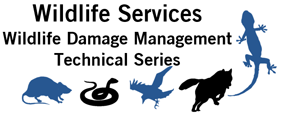United States Department of Agriculture: Animal and Plant Health Inspection Service

Wildlife Damage Management Technical Series
Date of this Version
12-2018
Document Type
Article
Citation
Vantassel, S.M. and B.K. Osthus. 2018. Safety. Wildlife Damage Management Technical Series. USDA, APHIS, WS National Wildlife Research Center. Fort Collins, Colorado. 19p.
Abstract
Wildlife damage management (WDM) is an exciting field with many opportunities to provide solutions to the complex issues involved in human-wildlife interactions. In addition, WDM wildlife control operators (WCO) face a variety of threats to their physical well-being. Injuries can result from misused (Figure 1), faulty, or poorly maintained equipment, inexperience, mishandled wildlife, harsh weather, and dangerous situations, such as electrical lines. The goals of this publication are to: * Develop an awareness of safety issues and adopt a mindset of “Safety First”, * Review the major safety threats that WCOs face, * Provide basic information for WCOs to protect themselves, and * List resources for further information and training.
Although no statistics are available for the WDM industry in particular, the authors are aware of several instances where WCOs have lost their lives or suffered serious injuries while performing WDM.
While accidents do happen, most are preventable and occur due to hurried behavior, neglect of procedures, or lack of attention to the task at hand. The United States, Canada, and Mexico have agencies tasked with setting and enforcing standards to assure safe and healthful conditions for workers. The U.S. agency is the Occupational Safety and Health Administration (OSHA). In Canada, it is the Labour Program, and in Mexico, the Ministry of Labor and Social Welfare governs workplace requirements. Readers are encouraged to keep abreast of government safety regulations not only to follow the law, but also to maintain a safe working environment. Safety is an extremely broad and complex topic. The number and diversity of situations that pose safety risks to WCOs are numerous. This publication focuses specifically on safety risks to the WCOs’ physical wellbeing, such as injuries. Safety concerns pertaining to organizational design, worker supervision, disease, environmental or social catastrophes, or pesticides are beyond its scope.
Work in WDM poses many safety risks to those involved. Awareness, planning, and deliberate action can eliminate or reduce many threats. As the industry continues to develop, WCOs must keep up with new threats and safety practices to maintain their well-being. Following safe work practices helps to ensure WCOs remain on-the-job and injury free.
Included in
Behavior and Ethology Commons, Biodiversity Commons, Health Information Technology Commons, Occupational Health and Industrial Hygiene Commons, Other Animal Sciences Commons, Other Ecology and Evolutionary Biology Commons, Population Biology Commons, Public Health Education and Promotion Commons, Terrestrial and Aquatic Ecology Commons


Comments
Published by U.S. Department of Agriculture